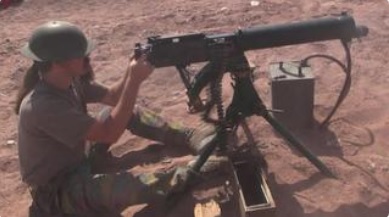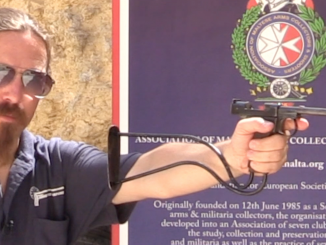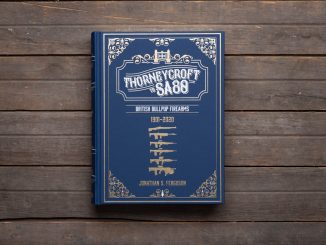The British lost some 90% of their stock of Bren light machine guns in the disastrous Dunkirk evacuation, and in the following months rushed to rearm. Part of this program was a two-tiered simplification of the Bren design. First was a MkI Modified Bren (which was not marked any differently than the original MkI), and this was followed by a MkII design. These patterns simplified many of the machining operation required to produce the Bren, significantly reducing the number of required machining operations. The most visually distinctive elements of the MkII pattern were the omission of the stainless steel flash hider assembly and the replacement of the original dial rear sight with a simple ladder sight. In addition, changes were made to the buttstock, buttplate, receiver profile, gas block, and bipod. Both Enfield and Inglis would produce the simpler MkII Brens by the middle of the war. Despite the many changes made, the core operating components (bolt, bolt carrier, etc) were left unchanged, so they could still interchange between all patterns of the gun in service.
Related Articles

Competition
Backlog of Video!
April 28, 2015
Ian McCollum
Competition, Heavy MGs, Interview, Revolver, Sniper Rifles, Submachine Guns, Video
13
While I have been posting daily videos from the recent series of Rock Island Auction material, I have also been publishing the occasional video on InRange TV – and some of those would probably be […]

Single-shot Pistol
Webley Model 1911 Stocked .22 Single-Shot Target Pistol
The Webley Model 1911 is a single-shot, self-ejecting target pistol made only for a few years. It was fitted with a long barrel to increase sight radius and also a detachable shoulder stock for those […]

Book review
Sneak Peek at Thorneycroft to SA80 with the Author, Jonathan Ferguson
Jonathan Ferguson, author of our newest Headstamp Publishing book “Thorneycroft to SA80: British Bullpup Firearms 1901-2020”, has just gotten his advance author’s copy of the book! Let’s join him to take a look through its […]

It’s amazing how guns travel around the world !Most of the rarest versions of SMLEs and Brens i’ve seen them on photos in the hands of Greek policemen(Gendarmerie), during the civil war.Even in the ’20s i’ve seen some with swedish mauser carbines, apparently in the same caliber with our famous malincher-schoenauers.Malinchers, and Steyr smgs that motorised police units had in 1940, were quite expensive for such a small country .
Was that clogging problem present only in early Bren LMG or it also plagued another ZB 26 offspring, namely MG 30(t) https://military.wikia.org/wiki/ZB_vz._30 ?
How did Vickers G.O. https://modernfirearms.net/en/machineguns/great-britain-machineguns/vickers-g-o-eng/ which also was firing ·303 cartridge and gas-operated coped with that?
I never read about clogging of ZB24/26 guns. The answer may be in propellant used. Brits used cordite produced with assistance of acetone. Original Czech powder was conventional nitrocellulose-nitroglycerin type.
Another clue might be location of gas tap; it is much closer to chamber on Bren. Typically cooler gas produces more deposits but it may not be a guide in this case.
It would be of use to peruse memories of Commonwealth servicemen in regard of Bren maintenance.
Ian, You neglected to mention the emergency Bren replacement, the BESAL. In 1940, the horrified Master General of the Ordnance and his minions realized, that with Inglis just starting manufacture, all it would take was one air raid on Enfield Lock and the British LMG program would come to a screeching halt. So the Czechs and BSA rode to the rescue with the BESAL:
“The Besal, properly named “Gun, Light, Machine, Faulkner, .303-inch”, was a light machine gun of British origin. The weapon was intended as an alternative to the Bren gun as it was lighter, simpler, cheaper and easier to manufacture and therefore was not dependent on the Royal Small Arms Factory, Enfield which was within range of German bombers. As the threat to the supply of Brens receded, it was eventually deemed unnecessary and never went into mass production.[1]
The design was by Henry Faulkner of the Birmingham Small Arms Company, which also manufactured the larger Besa machine gun which like the Bren was a product of the pre-war Czech arms manufacturer. That weapon’s name was a nickname for Birmingham Small Arms (BSA) and the Besal was to be a lighter version; a Besa-light. This was however not an official designation.”
And 80 or so years later, Gun Jesus did an episode on it:
https://www.forgottenweapons.com/besal-britains-emergency-simplified-light-machine-gun/
Fortunately the Luftwaffe never came calling, so it was never needed
A minor point, you may have noticed the holes in the bipod feet. They were used with a couple of spare tent pegs to lay the gun on a fixed line of fire – invaluable in poor visibility or night, when you want to lay down a wall of fire. US doctrine is that machine guns, unless actively engaged in a fire mission, are to be kept laid on the fixed line – known as a FPF (Final Protective Fire), that will interlock with the FPF’s of the the unit’s other MG’s just outside the wire, trapping the enemy in a wall of lead. We’re not so fancy as our cousins, we just cut two tree limbs, sharpen one end, pounded ’em into the ground, placing the gun in between these “sector limit stakes”
(hope this works)
https://images.search.yahoo.com/yhs/search;_ylt=AwrEeOLzKEBgyTUAbSIPxQt.;_ylu=Y29sbwNiZjEEcG9zAzEEdnRpZAMEc2VjA3BpdnM-?p=sector+limit+stake&type=wsg_fjnhltxzm_20_09_ssg00¶m1=1¶m2=f%3D7%26b%3Dchmm%26cc%3Dus%26pa%3Dwincy%26cd%3D2XzuyEtN2Y1L1Qzu0F0AzyyE0CtB0F0DzytB0C0EyEyDtDzytN0D0Tzu0StBzyzztDtN1L2XzuyEtFyCtCtFtDtFtCtBtBtN1L1Czu1BtCtN1L1G1B1V1N2Y1L1Qzu2SyDzztCzz0DzytDyBtGtAyDtAtDtGyEtC0B0AtGtDyE0FtCtGyEtAzy0EtCyEzz0CyE0EtC0B2QtN1M1F1B2Z1V1N2Y1L1Qzu2StDtD1SzyzytAzy1StGyDtBtAyCtGyEtD1StBtG1StCtD1QtGtB1QtB1Q1TtBzyzz1RtA1Rzz2QtN0A0LzuyEtN1B2Z1V1T1S1NzutByDzztAzztN1Q2Z1B1P1RzutCyDzztBzytCyEyCyBtA%26cr%3D1815268838%26a%3Dwsg_fjnhltxzm_20_09_ssg00%26os_ver%3D10.0%26os%3DWindows%2B10%2BHome&hsimp=yhs-fullyhosted_003&hspart=iry&ei=UTF-8&fr=yhs-iry-fullyhosted_003&guce_referrer=aHR0cHM6Ly9zZWFyY2gueWFob28uY29tL3locy9zZWFyY2g7X3lsdD1Bd3JDNFN1eUtFQmczUzBBR3c0UHhRdC47X3lsYz1YMU1ETWpFeE5EY3dNRFUxT1FSZmNnTXlCR1p5QTNsb2N5MXBjbmt0Wm5Wc2JIbG9iM04wWldSZk1EQXpCR1p5TWdOellpMTBiM0FFWjNCeWFXUURVRmhQU0RoZlVHbFRUbUZqUkVOS1QxWkJVMll5UVFSdVgzSnpiSFFETUFSdVgzTjFaMmNETVFSdmNtbG5hVzREYzJWaGNtTm9MbmxoYUc5dkxtTnZiUVJ3YjNNRE1BUndjWE4wY2dNRWNIRnpkSEpzQXpBRWNYTjBjbXdETVRnRWNYVmxjbmtEYzJWamRHOXlKVEl3YkdsdGFYUWxNakJ6ZEdGclpRUjBYM04wYlhBRE1UWXhORGd4TnpVeU5BLS0_cD1zZWN0b3IrbGltaXQrc3Rha2UmZnIyPXNiLXRvcCZoc3BhcnQ9aXJ5JmhzaW1wPXlocy1mdWxseWhvc3RlZF8wMDMmcGFyYW0xPTEmcGFyYW0yPWYlM0Q3JTI2YiUzRGNobW0lMjZjYyUzRHVzJTI2cGElM0R3aW5jeSUyNmNkJTNEMlh6dXlFdE4yWTFMMVF6dTBGMEF6eXlFMEN0QjBGMER6eXRCMEMwRXlFeUR0RHp5dE4wRDBUenUwU3RCenl6enREdE4xTDJYenV5RXRGeUN0Q3RGdER0RnRDdEJ0QnROMUwxQ3p1MUJ0Q3ROMUwxRzFCMVYxTjJZMUwxUXp1MlN5RHp6dEN6ejBEenl0RHlCdEd0QXlEdEF0RHRHeUV0QzBCMEF0R3REeUUwRnRDdEd5RXRBenkwRXRDeUV6ejBDeUUwRXRDMEIyUXROMU0xRjFCMloxVjFOMlkxTDFRenUyU3REdEQxU3p5enl0QXp5MVN0R3lEdEJ0QXlDdEd5RXREMVN0QnRHMVN0Q3REMVF0R3RCMVF0QjFRMVR0Qnp5enoxUnRBMVJ6ejJRdE4wQTBMenV5RXROMUIyWjFWMVQxUzFOenV0QnlEenp0QXp6dE4xUTJaMUIxUDFSenV0Q3lEenp0Qnp5dEN5RXlDeUJ0QSUyNmNyJTNEMTgxNTI2ODgzOCUyNmElM0R3c2dfZmpuaGx0eHptXzIwXzA5X3NzZzAwJTI2b3NfdmVyJTNEMTAuMCUyNm9zJTNEV2luZG93cyUyQjEwJTJCSG9tZSZ0eXBlPXdzZ19mam5obHR4em1fMjBfMDlfc3NnMDAmX2d1Y19jb25zZW50X3NraXA9MTYxNDgxNzU1Mw&guce_referrer_sig=AQAAALEX6Ayb1ryOoeTOql44eV06Vivgyk1XhMO-t5vHUSSyTIZ679gm19S4is155eZroQn0zZ_RRmibNvOCGQWUVhUNIwSmHrB_ie_MLStuutznh-xYw4HGE5CX9AnDH3sekS2mPJeq566erD9896UmbvJpX-ny_ozRPg4cJkClyWlv&_guc_consent_skip=1614817556#id=2&iurl=https%3A%2F%2Fwww.bevfitchett.us%2Fsquad-automatic-weapon-m249%2Fimages%2F3480_65_47.jpg&action=click
Actually the intention of the two holes of the bipod feet were the same as those on the BREN, these were used to fit onto the two appropriate studs on the ledge of the gun aperture on the front of the Universal Carrier (the so called BREN Carrier). These provided a secure mount for the gun, and allowed a degree of flexibility in firing. The use of two stakes was exactly the same as the US, only the initial Handbook for the BREN, stated that bricks, or water filled one gallon disposal petrol cans could be used or suchlike could be used instead.
I should have wrote that the gun aperture was on the left hand side of the (right hand drive) of the carrier, within what was described as the ‘Sponson’ (meaning a projection standing out from a warship’s side. a gun platform.)
I am surprised the BESAL was not put into production. Britain was desperately short of arms in 1940/1, and the example of the Sten shows that we were not too proud to produce a gun that worked, even if it did not look like a traditional gun.
The Bren stayed in service until the 1990s. I am sure that BESALs would not have lasted so long, but they did not need to. What was needed was a cheap machine gun which could be made in any machine shop, and the BESAL fitted the bill.
“the BESAL was not put into production” Quite simple really, it was just an example of Emergency Planning (Plan B). It just was not needed, it would have required a substantial amount of effort to get it fit to be issued to troops, in the form that is displayed it was a pretty ineffective weapon. There were large stocks of Lewis Guns, and Hotchkiss light guns in storage, with training units, artillery regiments and similar none infantry units were stripped of their Bren’s. By the end of June, all infantry units in the area of potential invasion, and the Mobile Response Force had Bren’s up to their establishment.
And by June all manufacturing facilities (as with those for other weapons of war) were working flat chat on production (2×12 hour shifts per day, 7 days a week). By the beginning of DEC 40 all Field Army units in the UK were fully equipped with Bren’s, with the Lewis and Hotchkiss issued to the Home Guard for field use; and airfield defence and Merchant Navy for light AA defence.
DUGELBY Thomas B. The Bren Gun. Collector Grande Publications, Coburg, Ontario, Canada, Revised and Expanded Edition, 1999. gives good background information. With the Home Guard story in MACKENZIE S.P. The Home Guard . A Military and Political History. Oxford University Press, Oxford, 1995.
In spite of the mythology, many units in the BEF brought their Bren’s and 2in Mortars back with them. And of course those BEF units evacuated in a orderly fashion from the French Atlantic ports, brought much of their equipment with them, see TACKLE Patrick. The British Army in France after Dunkirk. Pen & Sword Books, Barnsley, 2009.
A uncle who was in 1940 a RAOC Artificer Sergeant Major (ASM) in a Searchlight Regiment, taking his Light Aid Detachment (LAD) to Saint Nazaire, having a number of artillery men (mainly drivers) with him. Arriving at a Advanced Ordnance Depot outside the port, its Officer Commanding stated to him if he wanted he could take out attractive stores. Taking four Seven Ton Guy lorries, they loaded with specialist machine tools and similar, boxes of prismatic compasses, binoculars, survey equipment and FIFTY Bren guns in their cases. And they mounted Brens for AA defence on each vehicle. He also brought out four unknown boxed weapons, Thompson 1928 SMGs!
Gordon:
I just meant that the Besal, like the Sten, could be made in workshops that were not traditional gun makers. There is no harm in getting as much automatic firepower as possible out there. The fact that the Bren in the UK was only made at Enfield did not change, and having dispersed production of a simplified LMG would have been a good thing.
As to the army being fully re-equipped with Brens by December 1940, well, I’ll have to take your word for it, but that sounds like a heroic feat of production.
The family anecdote about finding four Thompsons amongst the stuff brought back from France is interesting, as I was not aware that Britain had bought any before the fall of France. However, I believe the French may have bought some, I wonder if that was the source?
Guess it didn’t — do down to section 6.4 of this document
https://www.bevfitchett.us/squad-automatic-weapon-m249/area-targets.html
https://youtu.be/vMKn3BBaC_U at 0:09
A Bren Mk I “modified” style buttstock with no shoulder stop pad, a Mk I style sight, a Mk II barrel (no stainless steel flash hider). Is that the Mk III Bren that Ian was speaking of ?
I think that the Canadians produced a simplified Mk 1 they called the Mk1 M
And here is a detail of MkI M you mentioned
http://www.jaybe-militaria.co.uk/ekmps/shops/barter/images/deactivated-canadian-built-bren-mk1m-1941-dated-sold-%5B5%5D-878-p.jpg
May I suggest, instead of picking on Ian (he did not mention this or that), to look at one of previous presentations. It covers BREN gun production at J.Inglis factory in Canada https://www.forgottenweapons.com/canadian-8mm-sterile-bren-gun/
There were couple of them before and after this. Just go and search on your own; become bona-fide BREN researcher 🙂
If you search, you find. Here is a picture of MkII. Does it not look fantastic? https://pbs.twimg.com/media/EgcUB2zXcAUTBgL.jpg
“…Does it not look fantastic?..”(C)
Not bad.
For photoshop. 😉
Great photo. The shorter and lighter barrel looks more like a Mk3 I think.
Ian needs to do an L4A4 video. Best Bren ever?